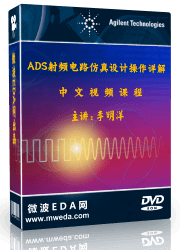- 易迪拓培训,专注于微波、射频、天线设计工程师的培养
[moved] How to simulate the conversion efficiency of the rectifier circuit by ADS
I am now doing the study of 2.45GHz rectenna circuit.
I am now simulating the conversion efficiency of a half-wave rectifier in ADS.
I want to calculate the power conversion efficiency by the function of : efficiency=Pload/Pin
I use the LSSP simulation and add to P_probe in the output port and input port to measure the Pload and Pin, but seems some warning happens.
Can anyone help to solve the problem?
The warning message is :" P_Probe1:Unable to resolve variables or functions in expression p=real(deltav*conj(sh1.i))"
Thank you very much!
Show me schematic.
Hi I cannot upload pic through lab's pic, so I draw it bymyself.
You can have look at it, I just want to calculate the conversion efficiency

Add HB Analysis Controler.
Thanks for your reply. I change he LSSP to HB simulation, then it's ok to probe the power. Now i get twp questions about this:
1. Why the P_probe cannot work in the LSSP simulation and the erro message occur
2. In HB simulation, the input power P_probe consist of several parts: P_probe[0](DC power), P_probe[1](Power in fundamental freq) and P_probe[2], it can be found that P_probe[0], P_probe[2] are both negative, why the value is negative?
when we calculate the power efficiency, what kind of equation should i use? Eff=P_probe2/P_probe1 or EFF=P_probe/P_probe[1]
You don't have to remove LSSP Analysis Controler.
HB Analysis Controler and LSSP Analysis Controler can coexist.
LSSP Analysis is no more than HB Analysis, however it does not save any voltage and current.
Are their absolute values very small ?
Show me results of P_probe[0], P_probe[1] and P_probe[2].
http://edadocs.software.keysight.com...ageId=82848108
Eff=P_probe1[0] / P_probe2[1]
or Eff=P_probe1[0] / sum(P_probe2).
Thank you very much for your reply.
1. Yes, the value of P_probe2[0] and P_roble2[3] is negative and the absolute values are very samll comparing with P_probe2[1]
Would you please help to explain, why the value is negative and why the values are very small?
2. In your equation "Eff=P_probe1[0] / sum(P_probe2)", what does sum(P_probe2) means, is it equal to P_probe2[1]?
3. When i use the he function Eff=P_probe1[0] / P_probe2[1] to calculate the efficiency, does this function include the impedance mismatch? or the function Eff=P_probe1[0] / P_probe2[1] is an ideal equation without return loss(S11)?
Surely respond to my question.
Show me numerical values of P_probe[0], P_probe[1] and P_probe[2].
I think it is due to numerical error.
Order of your 1-Tone HB Analysis is 3, it is too small.
Increase Order, e.g. Order=15, then show followings.
(1) Order=3
P_probe[0], P_probe[1], P_probe[2], P_probe[3]
(2) Order=15
P_probe[0], P_probe[1], P_probe[2], P_probe[3], ...., P_probe[15]
Numerical Lists as Watt
and
Plot dBm(P_probe) as Y-axis with X-axis as index or frequency.
They are not same strictly.
However they are almost same, I think.
No.
Use Eff=P_probe1[0] / dbmtow(PindBm) instead.
Here PindBm is a available power of Port1.
P_probe2[1] = dbmtow(PindBm) * (1 - |S11|**2)
申明:网友回复良莠不齐,仅供参考。如需专业帮助,请学习易迪拓培训专家讲授的ADS视频培训课程。
上一篇:Grounding problem (ADS Momentum)
下一篇:ADS rectifier circuit efficiency vs input power
ADS中文视频培训教程 | More...
 国内最全面、最专业的Agilent ADS培训课程,可以帮助您从零开始,全面系统学习ADS设计应用【More..】
国内最全面、最专业的Agilent ADS培训课程,可以帮助您从零开始,全面系统学习ADS设计应用【More..】
- Agilent ADS教学培训课程套装
- 两周学会ADS2011、ADS2013视频教程
- ADS2012、ADS2013射频电路设计详解
- ADS高低阻抗线微带滤波器设计培训教程
- ADS混频器仿真分析实例视频培训课程
- ADS Momentum电磁仿真设计视频课程
- ADS射频电路与通信系统设计高级培训
- ADS Layout和电磁仿真设计培训视频
- ADS Workspace and Simulators Training Course
- ADS Circuit Simulation Training Course
- ADS Layout and EM Simulation Training Course
- Agilent ADS 内部原版培训教材合集








